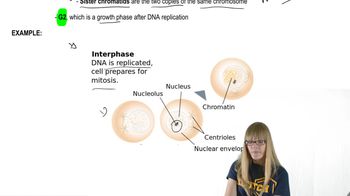Table of contents
- 1. Introduction to Genetics51m
- 2. Mendel's Laws of Inheritance3h 37m
- 3. Extensions to Mendelian Inheritance2h 41m
- 4. Genetic Mapping and Linkage2h 28m
- 5. Genetics of Bacteria and Viruses1h 21m
- 6. Chromosomal Variation1h 48m
- 7. DNA and Chromosome Structure56m
- 8. DNA Replication1h 10m
- 9. Mitosis and Meiosis1h 34m
- 10. Transcription1h 0m
- 11. Translation58m
- 12. Gene Regulation in Prokaryotes1h 19m
- 13. Gene Regulation in Eukaryotes44m
- 14. Genetic Control of Development44m
- 15. Genomes and Genomics1h 50m
- 16. Transposable Elements47m
- 17. Mutation, Repair, and Recombination1h 6m
- 18. Molecular Genetic Tools19m
- 19. Cancer Genetics29m
- 20. Quantitative Genetics1h 26m
- 21. Population Genetics50m
- 22. Evolutionary Genetics29m
9. Mitosis and Meiosis
Mitosis
Problem 5b
Textbook Question
If two chromosomes of a species are the same length and have similar centromere placements and yet are not homologous, what is different about them?
 Verified step by step guidance
Verified step by step guidance1
Identify the definition of homologous chromosomes: Homologous chromosomes are pairs of chromosomes that have the same structure and carry the same genes, although they may have different alleles.
Consider the genetic content: Even if two chromosomes are the same length and have similar centromere placements, they may not carry the same genes. This difference in genetic content is a key factor in determining whether chromosomes are homologous.
Examine the origin of the chromosomes: Homologous chromosomes typically come from different parents (one from the mother and one from the father). If the chromosomes in question are not homologous, they may originate from different species or be non-homologous chromosomes within the same organism.
Evaluate the gene sequence: The sequence of genes along the chromosome can differ, leading to non-homologous chromosomes despite similar physical characteristics.
Consider chromosomal rearrangements: Structural changes such as inversions, translocations, or duplications can result in chromosomes that appear similar but are not homologous due to differences in gene order or content.
Recommended similar problem, with video answer:
 Verified Solution
Verified SolutionThis video solution was recommended by our tutors as helpful for the problem above
Video duration:
2mPlay a video:
Was this helpful?
Key Concepts
Here are the essential concepts you must grasp in order to answer the question correctly.
Homologous Chromosomes
Homologous chromosomes are pairs of chromosomes in a diploid organism that have the same structure and gene sequence but may carry different alleles. They are inherited from each parent and play a crucial role in genetic diversity during meiosis. Understanding homologous chromosomes is essential for distinguishing them from non-homologous chromosomes, which may share similar physical characteristics but differ in genetic content.
Recommended video:
Guided course

Chromosome Structure
Chromosome Structure
Chromosome structure refers to the physical characteristics of chromosomes, including their length, centromere position, and banding patterns. While two chromosomes may appear similar in these aspects, they can still differ in their genetic information. This structural analysis is vital for identifying whether chromosomes are homologous or non-homologous, as it helps in understanding their functional roles in genetics.
Recommended video:
Guided course

Chromosome Structure
Genetic Variation
Genetic variation refers to the differences in DNA sequences among individuals within a species. This variation can arise from mutations, gene flow, and sexual reproduction, leading to diverse traits. In the context of the question, even if two chromosomes are similar in structure, they may differ in their genetic content, contributing to genetic variation and affecting traits expressed in the organism.
Recommended video:
Guided course

Genomic Variation
Related Videos
Related Practice





